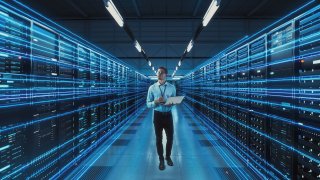AI’s Hidden Secret—Data Centers
The growth of artificial intelligence and cryptocurrency means that data centers—and the cheap, plentiful energy that powers them—will become ever more essential to national security.
As the public sphere brims with buzzwords like “AI” and “Crypto,” the national security community is still grappling with the implications of how the United States wields them as tools of statecraft.
Technology is always changing the global geopolitical power balance both militarily and economically. Cryptocurrency represents a potential threat to Washington’s favorite “big stick,” economic sanctions. For instance, Russian agents use Tether to circumvent sanctions and buy drone parts and weapons. Russia ends up being able to reap the benefits of a stable world-accepted currency while not having to play by the rules the United States dictates. This is setting a precedent that has been all but ignored by establishment politicians on both sides of the aisle. The National Security Agency is equipped to track some of these transactions. Yet, they cannot interfere with the flow of the currency, a particularly perplexing proposition for lawmakers with an, at best, cursory understanding of this particular mode of exchange.
Artificial Intelligence has created new predictive and early warning capabilities, such as predicting elections, crop growth, revenue flows, and military movements, all of which have sizable strategic and military implications. Small connected and AI-integrated military detachments are the future of effective warfare, and many nations are starting to take notice. Yet, the DOD has not made enough of an effort to procure and integrate AI into U.S. military operations. This places the military in a similar position to the early years of the War on Terror, completely unprepared to fight a new type of enemy that moved and fought faster than the top brass had imagined.
Yet, there is a serious deviance between the perceived impacts of these technologies and the actualities of their implementation. The more mundane issues of power consumption go mostly unnoticed by both leaders and the general public when discussing these new technologies and their impact on national security. In particular, there are specific infrastructure needs for anyone who wants to wield these tools.
AI is poised to become the oil of the future, and data centers are the oil fields from which it will be created. We are seeing the proliferation of AI in nearly every single industry, and in the near future, these industries will be reliant on AI to function properly. The larger the data centers, the more powerful the AI model. Yet, unlike almost any other business, they only require one major input: electricity—and massive quantities of it.
How much power will these technologies require? Currently, Bitcoin mining and support activities consume between 67 and 240 terawatt hours, or 0.2 to 0.9 percent of the entire world’s power consumption annually. On the AI front, the computing power required for its use doubles every 100 days and is forecasted to account for 4 percent of global electricity demand by 2028. The enormous power demands will mean that cheap energy rather than cheap labor will be the driving force behind tech companies’ choices of their centers of operation.
Hardware manufacturing is unlikely to shift away from East Asia, yet the data centers powering AI and cryptocurrencies will be built in areas with an abundance of cheap and reliable power. Land costs are nearly negligible compared with electricity and equipment costs. The importance of these data centers often gets lost in the glamor of the product they make possible.
In future conflicts, data centers will be the central nervous systems of any connected fighting force, and their protection or destruction will be a major determinant of the outcome of conflicts. Their utility will be on par with Britain’s chain home radar system during World War II. The data collected by every soldier, drone, plane, tank, and surveillance system has to be collected and interpreted into one picture of the entire battlefield, which commanders can use to make decisions. Currently, the storage and computing power needed to accomplish these tasks for a full-scale fighting force can only be found in a data center. However, mobile data centers are in development.
The good news is that AI and, to a lesser extent, cryptocurrencies have only recently begun maturing into widely pervasive technology. Though Washington is certainly behind the curve on both the legislation and implementation fronts, it is a matter of a few years behind, not decades, as with other issues. This leaves a relatively attainable path to catching up. Still, it starts with the education of our elected officials. Speech writers sprinkling buzzwords into their talking points like seasoning won’t cut it.
Fear is shaping the conversation on cryptocurrencies and AI in Washington, principally from a lack of understanding and education. Education must be the focus, as understanding will quell the fear of the unknown.
Adrian Kranz is president of Paratrade Corporation and a contributing writer for the Newport Global Summit.
Image: Gorodenkoff / Shutterstock.com.

